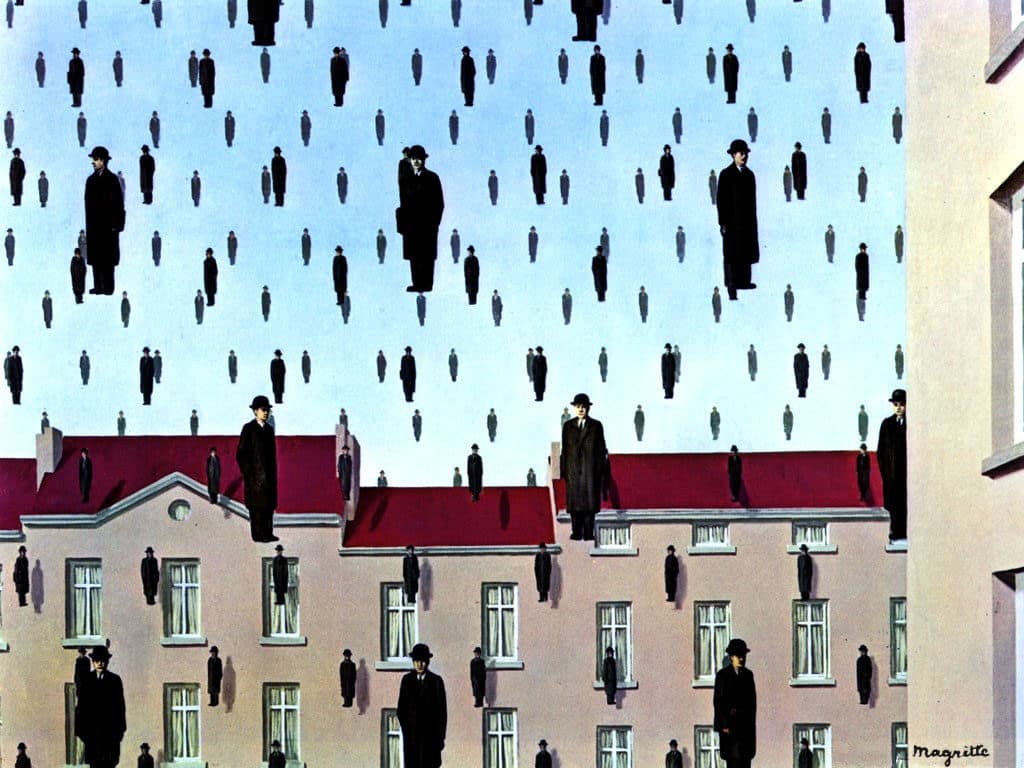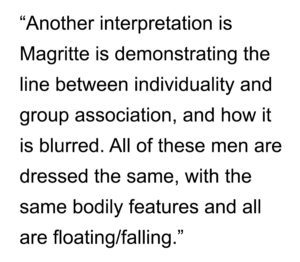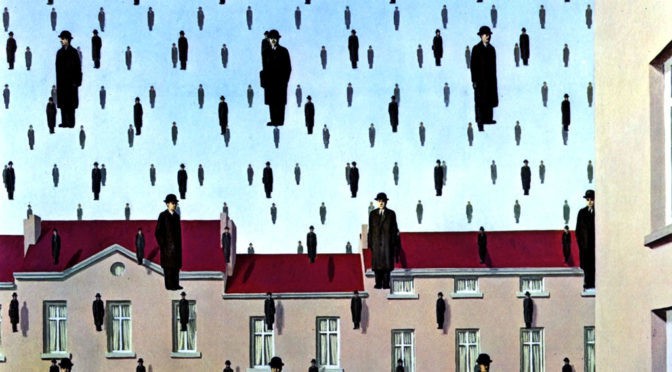
All That Floats | The City in Art
by Dr. Mark David Major, AICP, CNU-A

The selection of Rene Magritte’s Golconda (1953) for The City in Art series is a direct homage to Bill Hillier and Julienne Hanson’s The Social Logic of Space (1984), which famously used Magritte’s Golconda for its cover (see right). The piece depicts a scene of nearly identical men dressed in dark overcoats and bowler hats, who seem to be drops of heavy rain against a backdrop of buildings and blue sky (or to be floating like helium balloons, though there is no actual indication of motion). The latter is our preferred interpretation: hot air rises. These men are full of hot air because of their conformist nature, which causes them to float. The men are spaced in hexagonal grids facing the viewpoint and receding back in grid layers. Charly Herscovici, who was bequeathed copyright to the artist’s works, commented on Golconda: “Magritte was fascinated by the seductiveness of images. Ordinarily, you see a picture of something and you believe in it, you are seduced by it; you take its honesty for granted. But Magritte knew that representations of things can lie. These images of men aren’t men, just pictures of them, so they don’t have to follow any rules. This painting is fun, but it also makes us aware of the falsity of representation.” Another interpretation is Magritte  is demonstrating the line between individuality and group association, and how it is blurred. All of these men are dressed the same, with the same bodily features and all are floating/falling. This leaves us to look at the men as a group (Source: Wikipedia).
is demonstrating the line between individuality and group association, and how it is blurred. All of these men are dressed the same, with the same bodily features and all are floating/falling. This leaves us to look at the men as a group (Source: Wikipedia).
Mm, why might this be important when it comes to the subject of city planning, we pointedly ask? The use of Magritte’s Golconda for the cover of The Social Logic of Space is reminiscent of Jean Baudrillard’s quote in America (1982) that “space is what prevents everything from being in the same place.” However, it seems unlikely this was Magritte’s original intention since the buildings appear to be firmly anchored to the (unseen) ground outside the plane of the canvas. It is also interesting that the architecture in the painting can be characterized as equally conformist like the men in bowler hats. In any case, it is somewhat whimsical to take both Magritte and Baudrillard in tandem to suggest rather, it is gravity (of Nature, of the person, etc.) that keeps everything from floating away. Magritte’s Golconda is a wonderful painting precisely because of the obscurity of its real meaning about people and architecture.
 About Rene Magritte
About Rene Magritte
René François Ghislain Magritte (November 21, 1898–August 15, 1967) was a Belgian surrealist artist best known for witty, thought-provoking images and the use of simple graphics and everyday objects, thereby giving new meanings to familiar things. Magritte studied at the Académie des Beaux-Arts in Brussels from 1916 to 1918. Before finding success as an artist, Magritte designed wallpaper and advertisements. After a poorly received solo show in 1927, he moved to Paris and became involved with the surrealist movement. His surrealist style is mysterious and full of magic, created by combining realistic depictions of everyday objects in discrepancy with the known in perceiving everyday life. Magritte diverges proportions and changes the image’s texture. He combines real objects with abstract figurations. His most famous painting “La trahison des images” (Betrayal of the Images) (1929) shows a pipe with the words “Ceci n’est pas une pipe” (This is not a pipe) next to it. René Magritte died in Brussels on August 15, 1967 (Source: Wikipedia/Art Directory).
The City in Art is a series by The Outlaw Urbanist. The purpose is to present and discuss artistic depictions of the city that can help us, as professionals, learn to better see the city in ways that are invisible to others. Before the 20th century, most artistic representations of the city broadly fell into, more or less, three categories: literalism, pastoral romanticism, and impressionism, or some variation thereof. Generally, these artistic representations of the city lack a certain amount of substantive interest for the modern world. The City in Art series places particular emphasis on art and photography from the dawn of the 20th century to the present day.

